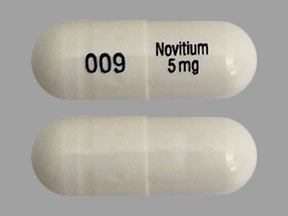Nitisinone Side Effects
Medically reviewed by Drugs.com. Last updated on Jan 18, 2025.
Applies to nitisinone: oral capsule, oral suspension, oral tablet.
Precautions
It is very important that your doctor check your or your child's progress at regular visits to make sure this medicine is working properly. Blood and urine tests may be needed to check for unwanted effects.
Check with your doctor right away if blurred vision, difficulty seeing at night, sensitivity of the eyes to sunlight, or any other changes in vision occur during or after treatment. Your doctor may want your eyes be checked by an ophthalmologist (eye doctor).
This medicine may also cause a delay in intellectual ability and growth development. Check with your doctor if you or your child has problems in intelligence, short-term memory, learning ability, and attention, or if your child has slower growth than normal.
Nitisinone can temporarily lower the number of white blood cells in your blood, increasing the chance of getting an infection. It can also lower the number of platelets, which are necessary for proper blood clotting. Avoid people with infections and check with your doctor if you have symptoms of an infection, such as fever or chills, cough or hoarseness, lower back or side pain, or painful or difficult urination. Call your doctor if you have any unusual bleeding or bruising, black, tarry stools, blood in the urine or stools, or pinpoint red spots on your skin.
The oral suspension contains glycerol and may cause diarrhea, an upset stomach, or headaches. Let your doctor know if you have these symptoms.
Serious side effects of nitisinone
Along with its needed effects, nitisinone may cause some unwanted effects. Although not all of these side effects may occur, if they do occur they may need medical attention.
Check with your doctor immediately if any of the following side effects occur while taking nitisinone:
Less common side effects
- black, tarry stools
- bleeding gums
- blindness
- blood in the urine or stools
- bloody nose
- blurred vision
- burning, dry, or itching eyes
- change in color vision
- chest pain or discomfort
- chills
- cough
- decreased vision
- difficulty seeing at night
- excessive eye tearing
- eye redness, irritation, or pain
- fever
- increased sensitivity of the eyes to sunlight
- painful or difficult urination
- pinpoint red spots on the skin
- redness, pain, swelling of the eye, eyelid, or inner lining of the eyelid
- sore throat
- sores, ulcers, or white spots on the lips or in the mouth
- swollen or painful glands
- unusual bleeding or bruising
- unusual tiredness or weakness
Rare side effects
- agitation
- back pain
- bluish color of the fingernails, lips, skin, palms, or nail beds
- confusion
- cough with mucus
- difficulty with breathing
- dizziness
- drowsiness
- fast heartbeat
- headache
- irritability
- seeing or hearing things that are not there
- seizures
- stiff neck
- tightness in the chest
- vomiting
Other side effects of nitisinone
Some side effects of nitisinone may occur that usually do not need medical attention. These side effects may go away during treatment as your body adjusts to the medicine. Also, your health care professional may be able to tell you about ways to prevent or reduce some of these side effects.
Check with your health care professional if any of the following side effects continue or are bothersome or if you have any questions about them:
Less common side effects
- dry skin
- hair loss or thinning
- itching or skin rash
- red, swollen skin
- scaly skin
Rare side effects
- cold sweats
- cool, pale skin
- depression
- headache
- increased hunger
- nausea
- nightmares
- shakiness
- slurred speech
- stomach pain
See also:
For healthcare professionals
Applies to nitisinone: oral capsule, oral suspension, oral tablet.
General adverse events
The more commonly reported side effects have included elevated tyrosine levels, thrombocytopenia, leukopenia, conjunctivitis, corneal opacity, keratitis, photophobia, eye pain, blepharitis, cataracts, granulocytopenia, epistaxis, pruritus, exfoliative dermatitis, dry skin, maculopapular rash, and alopecia.[Ref]
Hepatic
- Common (1% to 10%): Liver failure (7%), porphyria (1%)
- Frequency not reported: Hepatic function disorder, elevated hepatic enzymes, liver enlargement[Ref]
Hematologic
- Common (1% to 10%): Thrombocytopenia (3%), leucopenia (3%), granulocytopenia (1%), epistaxis (1%)
- Uncommon (0.1% to 1%): Anemia[Ref]
Metabolic
- Very common (10% or more): Elevated tyrosine levels (10% or greater)
- Uncommon (0.1% to 1%): Dehydration, hypoglycemia[Ref]
Nervous system
- Frequency not reported: Seizures, brain tumor, encephalopathy, headache, hyperkinesia, nervousness, somnolence[Ref]
Ocular
- Common (1% to 10%): Conjunctivitis (2%), corneal opacity (2%), keratitis (2%), photophobia (2%), blepharitis (1%), eye pain (1%), cataracts (1%)[Ref]
Oncologic
- Common (1% to 10%): Hepatic neoplasm (hepatic neoplasm [3.2%]; hepatic neoplasm, malignant [4.4%])
- Uncommon (0.1% to 1%): Benign brain neoplasm; lymphoma, malignant[Ref]
Dermatologic
- Uncommon (0.1% to 1%): Pruritus (1%), exfoliative dermatitis (1%), dry skin (1%), maculopapular rash (1%), alopecia (1%)[Ref]
Gastrointestinal
- Frequency not reported: Abdominal pain, diarrhea, enanthema, gastritis, gastroenteritis, gastrointestinal hemorrhage, melena, tooth discoloration[Ref]
Genitourinary
- Uncommon (0.1% to 1%): Amenorrhea, hematuria[Ref]
Musculoskeletal
- Frequency not reported: Pathological fracture[Ref]
Other
- Frequency not reported: Death, cyanosis, thirst, infection, septicemia, otitis[Ref]
Respiratory
- Frequency not reported: Bronchitis, respiratory insufficiency, cyanosis[Ref]
References
1. (2002) "Product Information. Orfadin (nitisinone)." Orphan Medical
More about nitisinone
- Check interactions
- Compare alternatives
- Pricing & coupons
- Drug images
- Dosage information
- During pregnancy
- Drug class: miscellaneous metabolic agents
- Breastfeeding
- En español
Patient resources
Other brands
Professional resources
Other brands
Related treatment guides
Further information
Nitisinone side effects can vary depending on the individual. Always consult your healthcare provider to ensure the information displayed on this page applies to your personal circumstances.
Note: Medication side effects may be underreported. If you are experiencing side effects that are not listed, submit a report to the FDA by following this guide.

